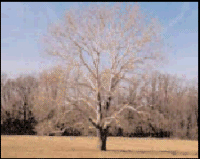 The Indians were the last inhabitants of Pencader to leave the land heavily forested. Compared to what was to follow, their villages and lifestyle consumed very little in the way of wood. Our poet Townsend described the view from the hill:
We think we see from some tall tree,
The Indians were the last inhabitants of Pencader to leave the land heavily forested. Compared to what was to follow, their villages and lifestyle consumed very little in the way of wood. Our poet Townsend described the view from the hill:
We think we see from some tall tree,
The blue-veined landscapes, where
One far-off streak is Chesapeake,
Another Delaware: Their long white length this knoll has strength
To sunder by its will;
It disarrays those mighty bays
The wand of Iron Hill.
G.A.Townsend
The history books state that Generals Washington, Greene and Lafayette were able to accomplish a crucial bit of reconnaissance by spying upon the British from the top of Iron Hill in an effort to assess General Howe's movements on the Chesapeake. From their vantage point it was reported they could see both the Chesapeake Bay, (Howe was landing at the Head of Elk) and the Delaware Bay. They must have climbed a very tall tree indeed to enjoy such a view as any person standing in the heavily wooded summit of the hill today can tell. It is more likely that the hill was partially devoid of trees at that time. Any history of the Iron Hill area must include the story of its trees. The virgin forest that sheltered the Native Americans, composed of giant oaks, hickories, chestnuts and maples, as well as persimmon, gum, sycamore, beech and numerous other species, was only looked upon as being of value to the settlers if it was in some way consumed. The journal of Isaac Weld, Jr., an Irish country gentleman travelling through
Cecil County, Maryland in 1795, describes the Americans' frame of mind concerning trees during that time:
The generality of Americans stare with astonishment at a person who can feel any delight at passing through such a country as this. To them the sight of a wheat field or a cabbage garden would convey pleasure far greater than that of the most romantic woodland views. They have an unconquerable aversion to trees; and whenever a settlement is made, they cut away all before them without mercy; not one is spared; all share the same fate, and are involved in the general havoc. ...the fact of the matter is that from the face of the country being entirely overspread with trees, the eyes of the people became satiated with them. The ground cannot be tilled, nor can the inhabitants support themselves, till they are removed; they are looked upon as a nuisance, and the man that can cut down the largest number, and have the fields about his house most clear of them, is looked upon as the most industrious citizen, and the one that is making the greatest improvements in the country.
The second factor in the destruction of the forests of Pencader and especially that of Iron Hill was the demand for charcoal to fuel the furnaces smelting iron for the local forges and blacksmith shops. As early as 1725 iron ore was being forged into bars on a small scale in the vicinity of Iron Hill. A typical large blast furnace of that time, one yielding two tons of iron daily, consumed the charcoal from one acre of woodland. A wooded area of 240 acres yielding 5,000 to 6,000 cords was necessary to feed a furnace kept in blast for a year. The number of woodcutters and charcoal burners necessary to keep a furnace in business far outnumbered the miners and furnace and forge crews. These men were called colliers and a rough lot they must have been. In order to produce charcoal, twenty to forty cords of wood were carefully arranged on a dry, sandy, level spot in the woods, protected from wind and water.
 A skilled collier would build a dome shaped kiln by arranging the logs, at first vertically in the center of the circle to form a chimney, and then gradually in a slanting position by turning the thickest ends downwards. The pile was covered with small limbs and chips, to fill in the crevices, followed by a two-inch covering of leaves and finally a layer of sandy, earthen dust. It was kindled at the bottom of the center, left to burn for twelve hours, covered with more dust and burned for three or four more days. After the outer cover sunk, hopefully evenly and regularly which produced the best grade of charcoal, the kiln was allowed to cool for four or five days.
The coal could then be raked off all around the foot of the kiln, cautiously, in order to prevent rekindling the pile. A wagonload at a time was taken off and the kiln recovered until the next wagon was ready to be loaded. A skilled collier would build a dome shaped kiln by arranging the logs, at first vertically in the center of the circle to form a chimney, and then gradually in a slanting position by turning the thickest ends downwards. The pile was covered with small limbs and chips, to fill in the crevices, followed by a two-inch covering of leaves and finally a layer of sandy, earthen dust. It was kindled at the bottom of the center, left to burn for twelve hours, covered with more dust and burned for three or four more days. After the outer cover sunk, hopefully evenly and regularly which produced the best grade of charcoal, the kiln was allowed to cool for four or five days.
The coal could then be raked off all around the foot of the kiln, cautiously, in order to prevent rekindling the pile. A wagonload at a time was taken off and the kiln recovered until the next wagon was ready to be loaded.
As more and more of the forest was burned, the colliers, living in rude log huts, had to move farther and farther into the woods. With only other colliers, teamsters, and oxen for company for months at a time, legends of stills on Iron Hill producing a little bit of cheer are probably more fact than fiction. Not the type of laborers likely to keep journals, their life stories are only preserved in folklore.
Principio Furnace, in nearby Cecil County, was the largest furnace in the area and was close enough to be supplied with charcoal from Iron Hill. A report to John England, manager of Principio in 1727, listed 90 tons (11,880 bushels) of charcoal used to produce 40 tons of pig iron. Mr. England paid his colliers twelve shillings per hundred bushels.
Beneath its head the iron, red,
Of ancient ore banks stood,
Where goblin Swedes their evil deeds
Revealed in stains of blood;
Their metal arts our country hearts
Uncanny thought and ill,-
From murdered man the oxides ran
That tinctured Iron Hill!
G.A.Townsend
|
